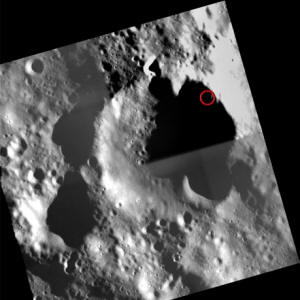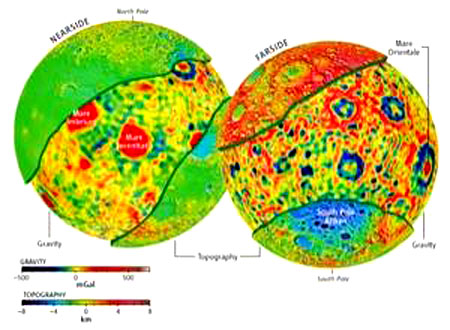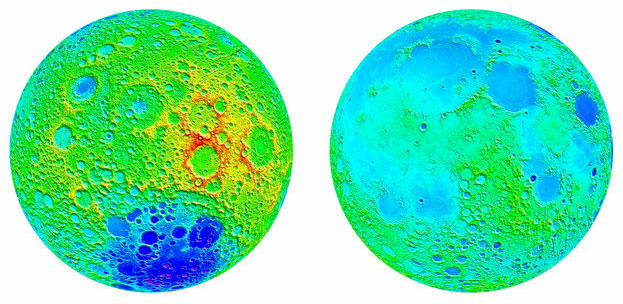|

by MacGregor Campbell
10 June 2009
from
NewScientist Website


Observers using the
Anglo-Australian Telescope took this series of 1-second exposures,
each snapped
0.6-seconds apart, around the predicted time of impact.
A bright flash can be
seen in the second image (centre of frame), and faintly in the third
and fourth as well
(Image: Jeremy
Bailey/University of New South Wales/Steve Lee/Anglo-Australian
Observatory)
Japan's
Kaguya lunar orbiter will end its
nearly two-year mission when it collides with the moon at 18:25 GMT
on Wednesday.
Observers in Asia and Australia may be
able to spot a bright flash or plume of dust from the crash, and
researchers will study its impact site to watch how radiation and
micrometeoroids weather the newly exposed lunar soil over time.
Launched in September 2007, Kaguya,
formerly known at SELENE, sought to shed light on the
formation and evolution of the moon by studying its composition,
gravitational field and surface characteristics.
Kaguya
deployed two smaller satellites
after reaching lunar orbit that allowed it to relay data to Earth
while it was on the moon's far side and to better measure anomalies
in the moon's gravitational field (see
First gravity map of moon's far side unveiled).

The Japanese probe
Kaguya has created the first map of gravity differences on the far
side of the Moon,
which always points
away from Earth.
The gravity
signatures of some craters suggests the far side might have been
stiffer and cooler than expected
(Illustration: Namiki
et al/AAAS)

The topography maps
and free-air gravity maps of the global Moon obtained by KAGUYA.
The far-side is on
the left and the near-side is on the right.
Touch the topography map with your mouse or pointer. Then the
gravity map will show up.
It also made the world's first HD video
of the lunar surface (below video).
Like previous lunar orbiters, including China's
Chang'e 1 and Europe's
SMART-1 probes, Kaguya will end its
voyage in a violent rendezvous with the moon's surface.
JAXA/KAGUYA Earth-Rise and Earth-Set image
over the moon
by
NnoxS3
November 13, 2007
from
YouTube Website
Heat and light
It is set to impact in the lower-right section of the moon's near
side (see images at top). Coming in at a very shallow angle – nearly
parallel to the ground – the probe has a high chance of skipping
across the surface, like a stone across a pond.
Ground-based observers are unlikely to see this skipping. But those
in Asia and Australia might be able to spot a plume of dust raised
by the impact, if it is backlit by the sun, like snow thrown up by a
skier ploughing through powder, says Bernard Foing, project
scientist of the European Space Agency's SMART-1 probe, which
impacted the moon in 2006.
Viewers may also see a brief flash as some of the kinetic energy of
the probe, which will be moving at 6000 kilometers per hour, is
converted to heat and light in the collision.
"It's a final show for
the Japanese people," says Shin-ichi Sobue, a researcher and
spokesperson for the Kaguya mission.
Foing says researchers can learn from these crashes.
"Impact is the
destiny of each orbiter," he told New Scientist. "We try to make use
of it as a research opportunity."
Space weathering
Peter Schultz, an expert on lunar impacts at Brown University in
Providence, Rhode Island, agrees. Depending on the specific terrain
of the impact site, the crash could leave an elongated scar,
exposing fresh soil, or regolith, to the harsh environment of space.
Scientists could watch how the lunar soil weathers over time under
solar radiation and bombardment by smaller meteoroids.
It would be
like "watching a wound heal", according to Schultz.
After the crash, attention will turn to
NASA's Lunar Reconnaissance
Orbiter (LRO) and Lunar Crater Observation and Sensing Satellite (LCROSS)
missions, set to launch a week after Kaguya's demise.
LRO will orbit the moon, studying its composition and topography and
searching for possible sites for future human bases, while LCROSS
will bombard one of the moon's polar craters with two heavy
impactors in search of water ice there.
|




